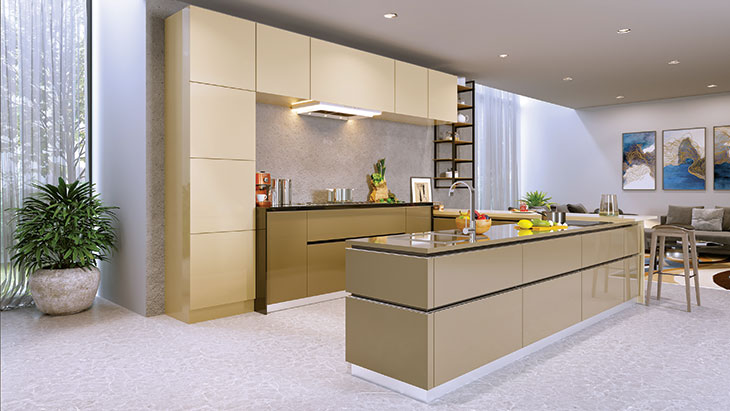First, back to the basics!

It’s been a long journey, from cement-and-stone structures supporting the cooking stove and storage hidden behind cloth curtains, to wood-based modular kitchens that are defined by ergonomics, efficiency, functionality and aesthetics.
Modern-day kitchens easily last a decade or longer. But it is in their practicality that modular systems stand out from the rest. Good design and preparation, combined with a choice of tested and certified materials, and topped with the latest technology in components, fittings and accessories – these are what constitute a sensible kitchen.
There are several factors that influence the design of a new kitchen. Foremost among them are the availability of space and dimensions of the new kitchen. This must also consider the number of people that need daily feeding; the type of cuisine that the kitchen will have to churn out regularly; the storage required for cooking materials, utensils, facilities, accessories and appliances.
Floor planning
For the facilities, there must be sufficient and customised connections for water, electricity, heating, cooling, lighting, air evacuation, washing and waste disposal. The type of storage (drawers, corner units, overhead cabinets, grain bins, pantry, appliance garage, etc.) will be determined by the eating habits of the family and cooking styles of the most frequent users of the kitchen.
The size of a kitchen these days is also decided by what function it plays in the household – whether it is a purely working kitchen, or a space for family get-togethers and culinary entertainment, or “show kitchens”!
Workflow planning, storage space and motion of articles are the key features of a practical kitchen. A well-planned kitchen can save a lot of manual work. If everything is stored where it is needed and within easy reach, it shortens distances and ensures smooth workflow.
A floor plan should, without fail, also incorporate ergonomic considerations, such as height of preparation and cooking platform; access to storage and cooking facilities; ease of operation of drawers, shutters and appliances; and safe disposal of organic and chemical waste.
Work zones
Firstly, cooking requires easy access to consumable and non-consumable materials, and convenient storage of utensils and cutlery. Second comes the food preparation area: washing raw material; cutting or kneading dough; steaming, frying, baking or freezing; and storing cooked food, whether in an oven, refrigerator or serving dishes.
A third consideration is waste disposal, followed by washing used utensils and safe storage of appliances.
These considerations are often referred to as ‘zones’. They are arranged clockwise for right-handed people, and in the opposite direction for people who are left-handed. Care must also be taken to incorporate other physical parameters of frequent users: his/her height, partial disabilities and xxx.
Optimising operations
The key to this is efficient and practical use of space. A limit to how much space you have doesn’t necessarily mean you have to compromise on your customer’s demands. Optimal use can be made – literally in every centimetre! – by opting for deeper cabinets, higher pullouts, tall pantry units, corner (magic) pullouts and table extensions.
Motion in kitchen furniture has a primary role to play in ease of functioning. Drawers and cabinets should be easy to open even while fully loaded. There should be efficient opening grips, self-stopping slides and dampened closing mechanisms.
Stays for lift-opening systems also need to be easy to access and operate. These opening/ closing systems are nowadays electrically driven. A light touch on the front with the hip, knee or foot is all that is required for drawers, pull-outs and even lift systems to open by themselves!
Now that you’re done with the basics, what next?
Comments

- ‘Red gazelle’ makes window installation easy
- Felder’s solutions for window and door production
- Versatile sliding-folding systems from Hafele
- Door line automation from Woodtech Consultants
- Accutec solutions for uPVC windows
- Jowat’s VOC-free primer for window profile wrapping
- Flexible solutions for doors, windows from SCM
- Tostem introduces Giesta steel doors; calls for dealers
- Folder system by Salice optimises cabinet space
- Turakhia has top-quality veneers for doors
- Mirka has solutions for difficult sanding of doors
- When Lamello’s Cabineo became a game changer
- Digital lacquer embossing for flooring from Hymmen
- Weber sanders help achieve luxury surfaces
- Hettich earns BIS nod for hinges, runners
- The importance of selecting the correct tools
- 3D is printing sustainable housing solutions
- Hard or soft? Researchers discover new wood type
- CLT shelter withstands severe seismic testing
- Japan World Expo gets largest wooden structure
- A collaboration of craft and (woodworking) culture
- ‘Reading consumer mindset is the key to success’
- PRECIOUS METTLE
- UF resin: blessing in disguise
- Cost savings for new factory investments
- ‘Natural’ is in, but efficiency is still at a premium
- What CAD, CAM software are best?
- Which drawer slides suit you best?
- First, back to the basics!
- Nolte Küchen has ₹17-cr plan for India expansion
- For compressed air, it’s Atlas Copco
- Häfele has fittings for all needs
- Holistic approach with Hettich’s magical solutions
- Salice’s Folder system optimises space
- WAF has two winning Indian entries
- Turkish designers delight with US hardwoods
- Decora joins hands with FFSC for skill academy
- Skill development comes to Udaipur’s furniture industry
- Forest management for sustainable supply from B.C. Canada
- New chapter in furniture innovation at CIFF 2025
- 3rd tech-together, exhibition at Hymmen
- imos organises Technology Day in Delhi
- Entries open for Interzum Awards 2025
- Ligna 2025 sees strong demand for participation
- MTC contest showcases creativity from wood waste
- TIWF 2024 concludes successfully
- Event-Calendar
- Egger’s ‘Capsule Concept’ creates harmonious décor
- Grass releases RAT system for cabinetry
- State-of-the-art edge bander from Jai
- SCM’s Balestrini centres for solid wood
- Sugatsune introduces new concealed hinge for doors
- Aryamman brings home Konrad Hornschuch products
- Automatic beam saw with twin pusher from Woodtech
- Seamless functional doors from Fiamarc
- Felder offers range of wide belt sanders
- OptiSaw 3.2 Panel Saw
- New guidelines to curb ‘green-washing’
- Ozone opens Experience Centre in Bengaluru
- Dieffenbacher takes over Schmidt & Heinzmann
- Egger invests in sustainability and automation
- Demand for American Oak soars in India
- Nitori to open first store in India
- Bureau Veritas acquires AI company
- Siempelkamp secures syndicated loan
- Merino to reduce carbon footprint
- Ebco’s new campaign features ‘Boom-Boom’ Bumrah
- SCM wins SMAU innovation award
- Unilin wins patent for flooring
- WhatsApp kicks off training for businesses
- SCM takes over Mecal Machinery
- Rajesh Mittal to head FIPPI
- Birla Opus opens fourth paints factory
- Greenply roots for ‘Pushpa 2’
- Wooden Street raises ₹354 cr. in funding
- Ashima Kaul recognized as top HR Leader









































